This past summer, on my way from Fort Collins, Colorado to Laramie, Wyoming, I took route 287. It traverses some low-relief outcrops of the “basement complex” igneous and metamorphic rocks that are part of the Wyoming Terrane (or “Wyoming Craton”) – an ancient micro-continent that annealed with other micro-continents to help comprise what we today call “North America.”
At the first outcrop at which I stopped displayed a fine ensemble of metamorphic rocks like gneiss and amphibolite, cross-cut by granitic dikes. Everything had been deformed by boudinage and folding on multiple scales. Here’s a few looks:
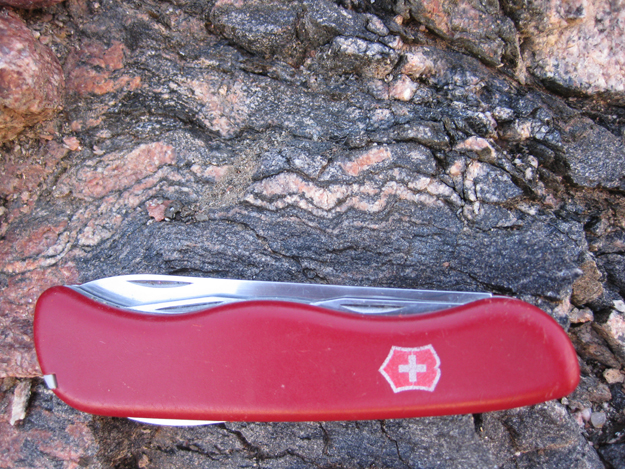
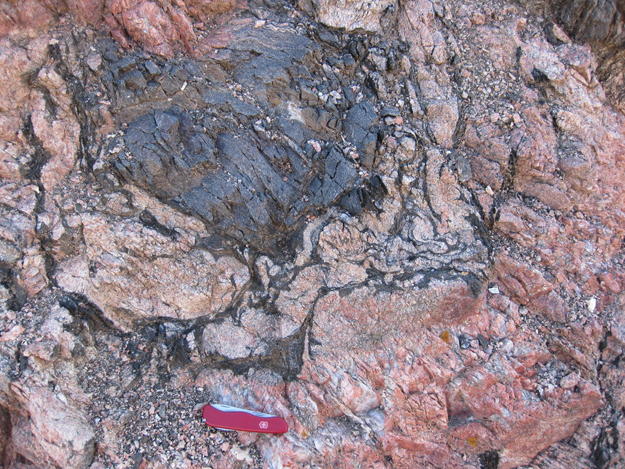
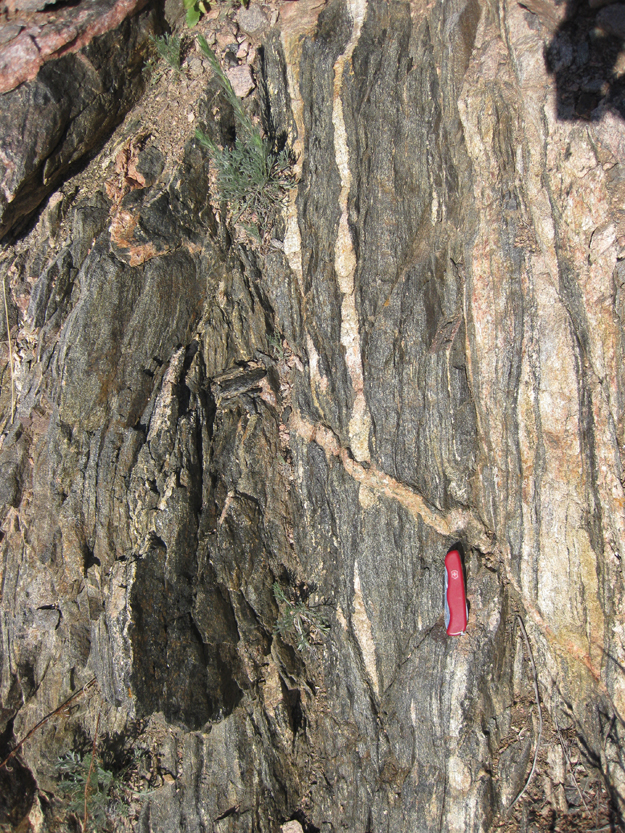
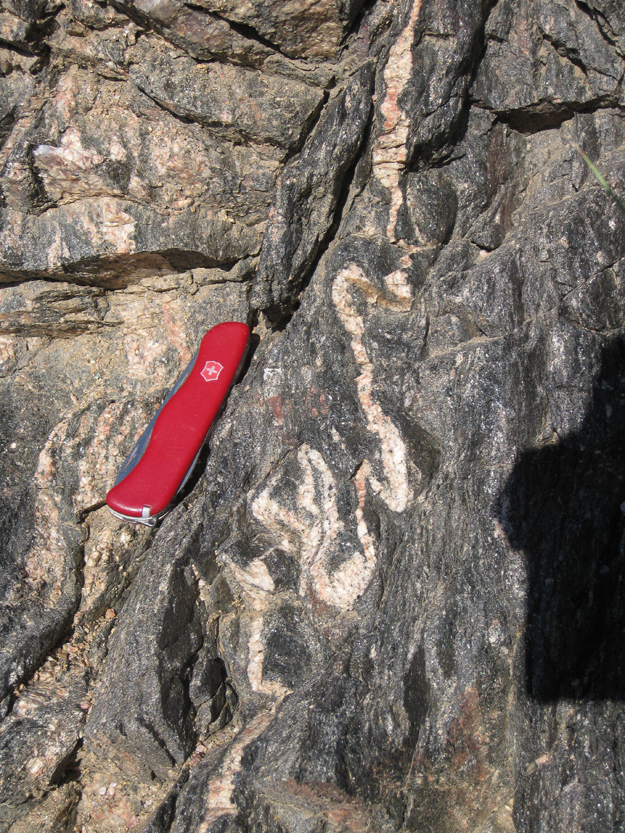
(In case you’re wondering why this looks familiar, I’ll remind you that a closer look at this last folded granite dike was featured as the Friday fold in early August.)
The second outcrop was dominated by intrusive igneous rocks. Here’s the entire outcrop in one panoramic view (click to enlarge):
The neat thing about this outcrop is that it’s polka-dotted!
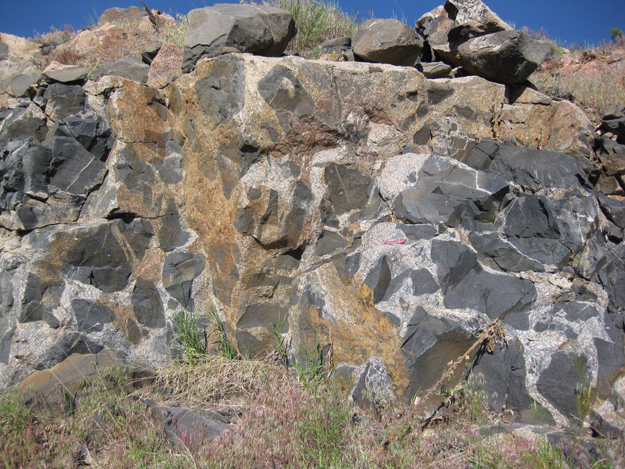
Nice contrast, eh? Dark, fine-grained inclusions in coarse-grained, light-colored granite. At first glance, these appear to be xenoliths, chunks of pre-existing mafic rock that had been broken off and stoped into the granite magma chamber before it crystallized and stiffened up (at the end of this post, we saw a lovely example of stoping in Patagonia’s Cuernos del Paine).
But wait… some of them look a little bit different:
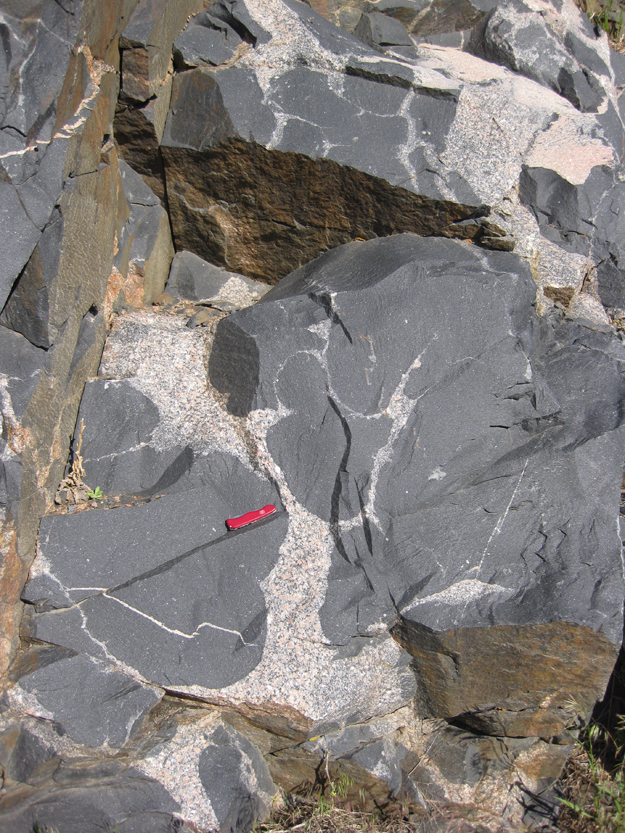
Note the round shapes of these mafic bits: perhaps they are not xenoliths at all, but microgranular mafic enclaves (MMEs), primary plutonic structures that result from the immiscibility of mafic and felsic magmas that mingle at depth. If they don’t mix, they can form blobs that are reminiscent of the round droplets of oil in salad dressing vinegar. Because oil and vinegar don’t mix, the salad dressing will self-organize into two separate bits after being shaken.
Looking at that last image, I’m struck by the way the dark bits (xenoliths? MMEs?) in the upper right are “penetrating” each other in broad, gentle curves.
Here’s a bunch of these rounded forms, all stacked up next to one another with very little granite to separate them, like sardines in a can:
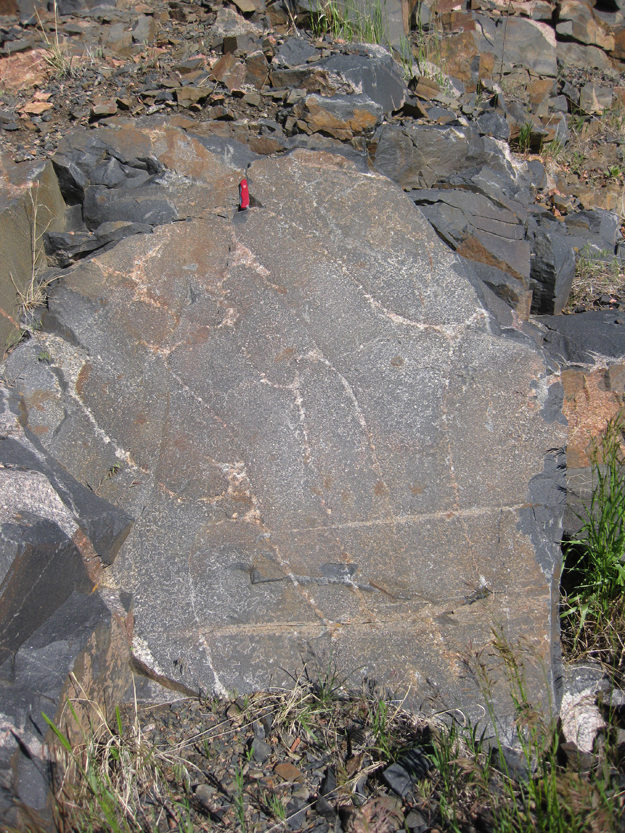
This reminds me strongly of the “Dalmatian” pluton I saw on the 2009 Owens Valley field forum. Again there, the question was: xenoliths or MMEs? If they are nice and round, it supports the MME interpretation.
…But then again, some of them are clearly angular:
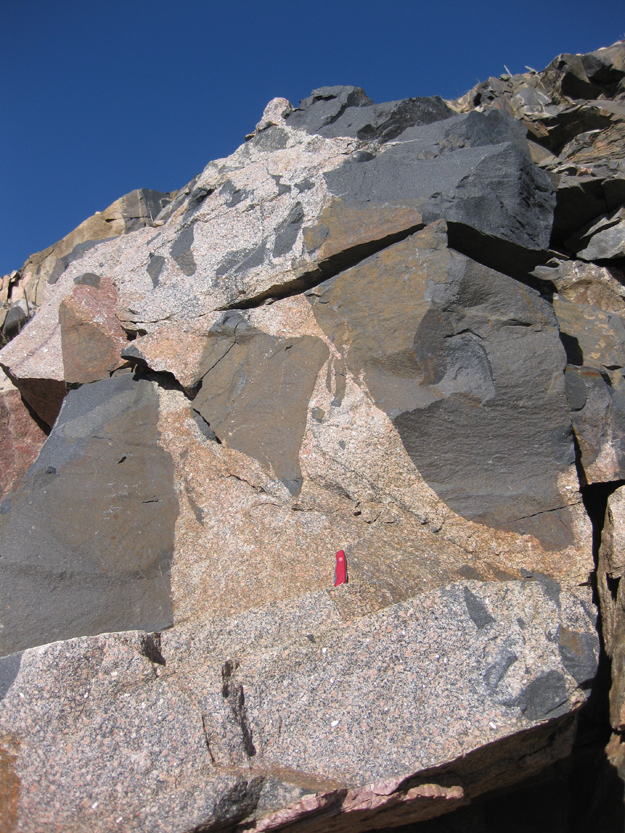
Those look more like xenoliths to me.
…As do these. You can even see a crack (an arcuate-shaped crack, at that!) extending across one in the middle:
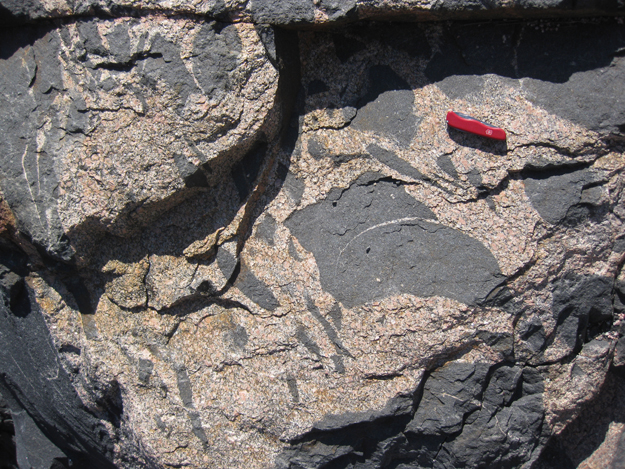
What the heck? How do we explain this variation? This next collection shows broad rounded corners on some of the mafic inclusions, while others show jagged, angular cracks (filled with pink granite):
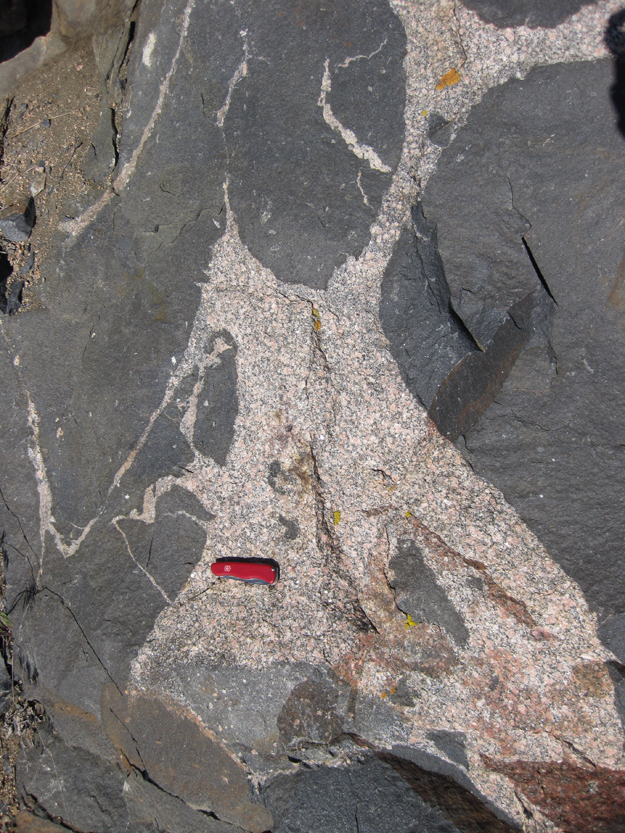
I’d love for an igneous petrologist to weigh in and let me (and us) know what they think is going on with this outcrop – how did these mafic inclusions form? Were they originally sold xenoliths that experienced some thermal erosion to make them round? Were they originally liquid immiscible blobs of mafic magma that later solidified and ripped into jagged pieces? Or perhaps a third possibility that I’m not imaginative enough to dream up?
One final photo – a treat for the structural geologists out there. Here’s an en echelon series of rips in the mafic rock, hosting small granitic intrusions:
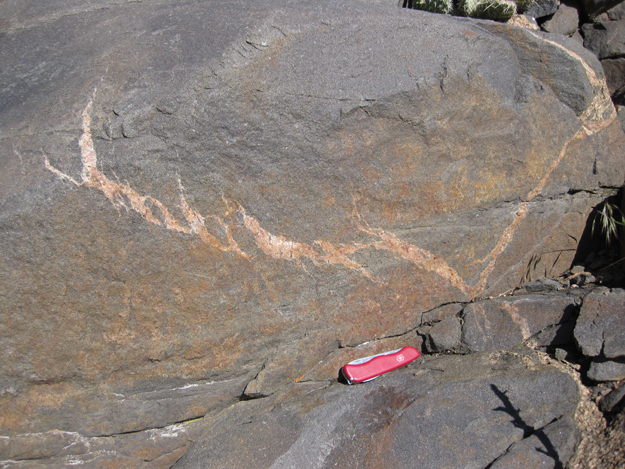
And that’s all you get – Reluctantly, I had to leave the outcrop and keep moving north up route 287 : I had an appointment to get attacked by a T. rex an hour later.


Picture co_basement_10 is similar to features in the Mooshorn Igneous Complex in the Calais area, Maine and in the Milford Granite in Milford and Hopkinton, Massachusetts. The interpretation by Malcom Hill and others in NEIGC and other field trips and publications is that these are pillow basalts (gabbro) within an igneous pluton. The two melts are contemporaneous and intermixed (comingled). They formed at the same time (coeval) from melting of metasedimentary rocks. I’ve seen outcrops of mafic dikes that apparently penetrate brittle granite, but terminate and branch into pillowed extrusions in what was apparently fluid granite.
Neat idea – magmatic pillows!!
I wonder about the lack of radial fractures and/or cooling rinds — simply too little of a thermal gradient between pillow interior and exterior for those features to develop?
An intriguing notion, nonetheless.
Two of the important references for Hill’s work are:
Hill, Malcolm, 1991, Petrology of the Moosehorn Igneous Complex, Calais, Maine, IN Ludman, Allan, ed., Geology of the coastal lithotectonic block and neighboring terranes, eastern Maine and southern New Brunswick: New England Intercollegiate Geological Conference Guidebook, 83rd Annual Meeting, Princeton, ME, September 27-28, 1991, p. 55-63.
Ludman, A., and Hill, M., 1986, Bedrock Geology of the Calais 15′ Quadrangle, Maine: Maine Geol. Survey, Open-File No. 86-72
Bob Wiebe from Franklin and Marshall pioneered this idea of “mafic pillow piles” with some work on Vinalhaven Island in Maine. I think the key here is that the gabbro intrudes and cools quickly, so some of the gabbro might behave as a solid to make more xenolithic-looking blocks and behave as a liquid/mush to make some of the more ductile looking contacts. They can be very complicated setting, but check out this paper on the Vinalhaven Pillow Piles … they will look very familiar:
http://minerva.union.edu/freyh/noprints/WiebeFreyHawkins2001.pdf
Way cool. Thanks for the link – yes, the visual match between the two locations is uniformitarianismically uncanny.
By the way, that paper by Wiebe, Frey and Hawkins was based off of Frey’s undergraduate thesis work on a Keck Project – go undergraduate research!
Where is this outcrop?
Somewhere along the west side of route 287 in northern Colorado…
Has anyone determined whether or not the MMEs and xenoliths match up (e.g., geochemically, petrologically and petrographically)?
I have no idea. This is just a roadside outcrop that caught my eye as I was driving by – not some research topic about which I have any expertise. It’s a great question, and I encourage some M.S. student at Colorado State University or the University of Wyoming (both of which are about equidistant from this outcrop) to investigate it and let us all know! 🙂
So, this is possibly what it looks like when the contents of a magma lamp solidify. Neat!
Fascinating blog you have here.
the quench temperature of the mafic melt is way above that for the granite. Probably mixing of two separate magma sources… but flowing into the relatively cool granite, the basaltic lava would indeed make pillow shapes and crack while moving/cooling like it does (much faster) in water at the surface.
I know this is an old(er) post, but I couldn’t help put a comment in here. I’m finishing up my grad studies at Colorado State Univ. The Virginia Dale Ring Dike structure is one we take our undergraduate IgMetPet classes to every year. I can’t give an in-depth comment on the petrology of the outcrop here, but it is a well studied area. If you search for Virginia Dale Ring Dike Complex, or something similar, you’ll find quite a bit of info on it. Hope this helps!
e.g. – “Virginia Dale intrusion, Colorado and Wyoming
Magma-mixing and hybridization in a Proterozoic composite intrusion”
doi: 10.2113/34.2.195
Structure and petrology of the Virginia Dale ring-dike complex, Colorado-Wyoming Front Range. David H Eggler, U of Colo. PhD thesis.
This outcrop has been mapped as one of the ring dikes in this complex which measures something like 100 or 150 sg miles. His thesis and later shorter papers written by him thoroughly cover these rocks, petrology, structure and geochemistry. Colorado State University M S students have written something like 10 or 15 dissertations on kimberlites, mantle and lower crustal xenoliths in the kimberlite diatremes, heavy mineral studies for KIM minerals (kimberlite indicator minerals) in stream sediments used to trace kimberlite outcrops of which there many in this complex, and adjacent areas, albeit some only a few acres.
I did my Ph.D. at Wyoming under several great hard rock and field geologist about 20 years ago. If you are interested I suggest you try to contact B.Ron Frost (retired) or Carol Frost. I have been to most of these outcrops on field trips and for fun. I believe these are interpreted as mafic co-mingling with the Sherman granite (A-type) Check out Rocky Mountain Geology, a publication of the Univ. of WYO, there are more than one issue devoted to the Wyoming province granites, and I believe one article is on this exact question. But my memory may be failing.
It is their mentoring me on these rocks that has led to my identifying similar in MN, where I now reside and teach.
Great; I’ll bring it up with Carol when I see her next.